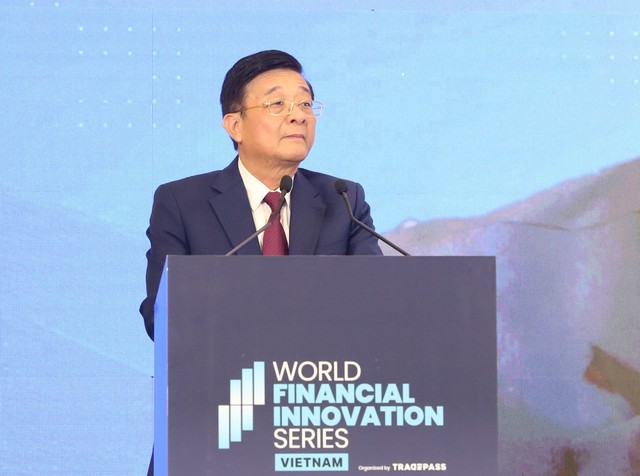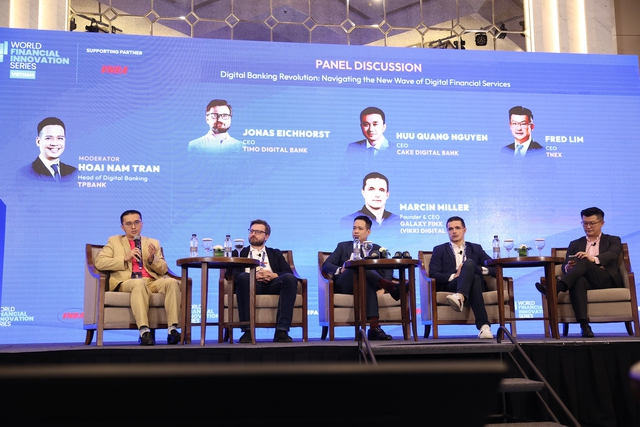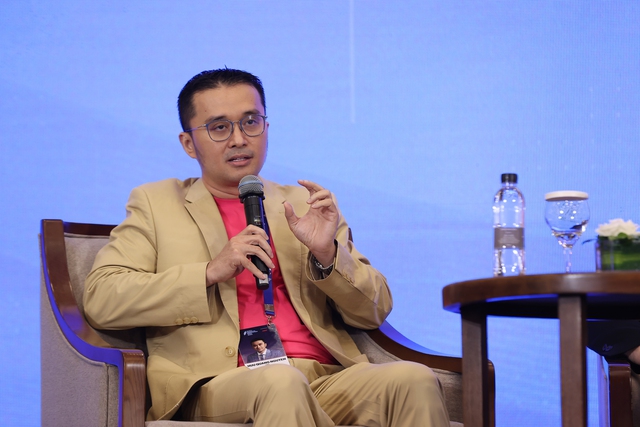Digital transformation has become an inevitable trend today, a top priority for development in most countries worldwide. In Vietnam, digital transformation is considered one of the main pillars of socio-economic development strategy, with the banking sector leading the way in terms of speed and strength.
Speaking at the World Financial Innovation Series (WFIS) – Vietnam 2024, held from April 15 – 16, 2024 in Hanoi, Mr. Nguyen Quoc Hung, Vice Chairman and General Secretary of the Vietnam Banks Association, said that this is the second time the Vietnam Banks Association has collaborated with TradePass to organize an event with the goal of promoting digital transformation in the financial banking sector and encouraging cooperation, creating a close-knit, efficient, and sustainable Fintech ecosystem in Vietnam.
In Vietnam, the Government has issued the “National Digital Transformation Program to 2025, with a vision to 2030” while the State Bank of Vietnam (SBV) has issued the “Digital Transformation Plan for the Banking Sector to 2025, with a vision to 2030”.
To date, most banks have developed digital transformation strategies and mobile and internet banking services. As of November 2023, the country has over 85 organizations providing payment services via the Internet and 52 organizations implementing mobile payments; 51 intermediary payment organizations licensed by the SBV are currently operating in the market.

Mr. Nguyen Quoc Hung, Vice Chairman and General Secretary of the Vietnam Banks Association, delivers the opening remarks at the WFIS Event
According to Mr. Hung, banks are also investing heavily in new technologies, core banking systems to serve digital transformation and applications in operations, specifically Blockchain technology, Artificial Intelligence (AI), and Biometric technology (voice recognition, face recognition, fingerprint, iris).
In the Fintech sector, the SBV has granted licenses to 48 non-bank intermediary payment service providers, including more than 40 e-wallet service providers. According to statistics from the SBV, the number of Fintech companies has increased fourfold, from 39 at the end of 2015 to over 154 at the end of 2021. Approximately 70% of Fintech companies in Vietnam are startups.
“In the coming period, the digital transformation process in the financial banking sector will continue to accelerate. The trend of banks cooperating with Regtech, Suptech, and Proptech is also starting to be implemented in Vietnam in various forms. Regtech is an application of information technology to support legal enforcement for financial institutions (Regtech for Financial Institutions); Suptech is an application of information technology to support legal enforcement for regulatory and supervisory agencies (Regtech for Supervisors); Proptech is an application of information technology and platform economics to the real estate market, also known as real estate technology,” Mr. Hung said.
How do digital banks attract customers?
Speaking at the conference, Mr. Fred Lim – CEO of TNex Digital Bank, believes that digital banking and traditional banking models have many differences, especially in terms of operating network and human resources. After a period of explosive growth, the traditional banking model has begun to slow down due to issues related to operating costs and rising product quality.
According to Mr. Lim, with their vast networks, traditional banks face more challenges in cutting costs. In addition, traditional banks cannot change their policies as flexibly as digital banks.
The TNex leader also indicated that the application of technology will provide digital banks with an advantage compared to traditional banks. It will also drive the development of comprehensive digital financial solutions in line with Vietnam’s national digital transformation vision.

Digital bank executives share insights at the World Financial Innovation Series (WFIS) – Vietnam 2024
Sharing at the conference, Mr. Nguyen Huu Quang – CEO of Cake by VPBank Digital Bank, said that although it has only been in operation for 3 years, the digital bank has served over 4.2 million customers with nearly 7,000 billion VND in savings deposits and generated 200,000 – 300,000 applications for credit cards and loans each month.
Explaining the reasons for this rapid growth, Cake’s leaders attribute the success of Cake by VPBank to focusing on user needs from the beginning and applying artificial intelligence.
According to Mr. Quang, the two target customer groups at Cake are from 22-30 years old and 30-40 years old. This group of customers wants to use services that are fast, simple, convenient, and ready to try new services. Therefore, the digital bank uses AI to create products that deliver fast, seamless, and personalized user experiences.
“No single bank can meet the needs of all customers. We will select the most suitable customer segments and invest our resources in them. When entering the market, we always identify our target customers and understand their needs. We design products that suit each age group,” said Mr. Quang.
Thanks to artificial intelligence, customers can register for any financial service on Cake in less than 2 minutes, much faster than traditional financial models, according to the CEO.
Customers who need urgent cash can use Cake to meet their immediate financial needs such as grocery shopping, shopping, coffee, travel, etc. On the Cake app, the product development team has also integrated various services such as bill payment, quick cash advances, savings accounts, credit cards, mutual fund certificates, etc.
In the next phase, this digital bank aims to continue providing financial services and solutions that are “tailor-made” to the needs, behaviors, and habits of its target customer base. Generative AI will be the tool used to solve this challenge.
“We will drive forward and position Cake by VPBank as the ‘Next Gen AI Bank’ within the next 3 years,” said Nguyen Huu Quang.
Mr. Quang believes that the formula for Cake’s success within the last three years is a combination of building a clear orientation, identifying the core customer group as those who have not had access to digital financial products or have not been adequately served by traditional banks. In the next step, Cake uses technology to optimize operating and management costs while developing a range of high-quality products to increase customer adoption.
Combined with Generative AI, Cake leaders expect this formula will help pure-play banks provide better customer experiences, optimize revenue streams, become profitable, and achieve sustainable growth.

Mr. Nguyen Huu Quang – CEO of Cake by VPBank Digital Bank
Also according to CEO Nguyen Huu Quang, Cake’s customer acquisition cost is only 20% of traditional models. The cost of servicing a customer at Cake is only 25% of traditional channels, due to operating on a digital platform and automating most processes. Therefore, Cake’s profit margin is comparable to traditional banks despite its significant investment in technology.
According to Mr. Quang, only about 5% of digital banks in the world are profitable because most services are provided free of charge. “We are developing at a good scale in Vietnam and are on our way to being among the top 5% of profitable digital banks in the near future,” Quang said about Cake by VPBank’s goal.













